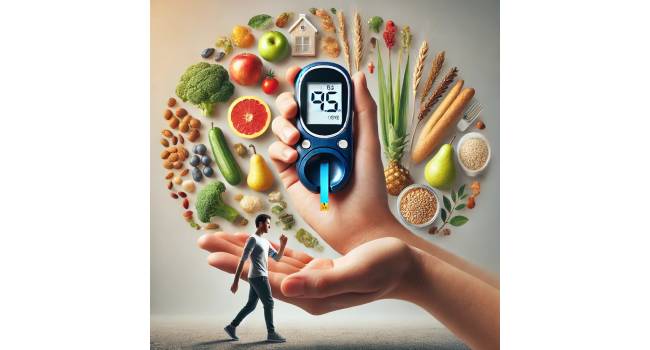10 Ways to Prevent Post-Meal Blood Sugar Spikes
Blood sugar spikes, especially after meals, are common in people with diabetes, but they can also affect those who do not have the condition. When we consume high-carb foods or meals with a high glycemic index (GI), our blood sugar levels tend to rise. While the pancreas releases insulin to control this surge, an insufficient amount of insulin can lead to a risk of type 2 diabetes, heart disease, kidney damage, and more. Thankfully, post-meal blood sugar spikes can be managed with a few lifestyle changes. Here are 10 Ways to Prevent Post-Meal Blood Sugar Spikes
1. Eat More Fiber
Fiber plays a crucial role in controlling blood sugar levels by slowing down the absorption of Glucose into the bloodstream. Foods rich in fiber, such as whole grains, vegetables, and legumes, can help prevent sugar spikes. Scientific Research found that individuals who consumed higher amounts of cereal fiber had a significantly lower risk of developing type 2 diabetes.
On the other hand, Millet, a gluten-free grain, offers an excellent alternative to wheat for diabetics. Rich in fiber, vitamins, and minerals, millet has a low glycemic index, meaning it releases glucose into the bloodstream slowly. This helps maintain stable blood sugar levels and improves digestion. Millet is also packed with antioxidants and magnesium, which can aid in reducing insulin resistance, making it a valuable dietary option for individuals with diabetes looking to replace gluten and lactose-rich foods.
2. Take a Post-Meal Walk
A simple and effective way to manage blood sugar is by taking a walk after meals. Even just two minutes of walking or standing can help control glucose levels. A 2022 study published in Sports Medicine found that post-meal exercise, such as walking, is more effective for glycemic control in people with type 2 diabetes than a one-time, daily workout.
3. Reduce Portion Size
Large meals can lead to a greater surge in blood sugar levels. To prevent this, opt for smaller portions of food spread throughout the day. Eating several small meals instead of one large one will help keep glucose levels more stable by reducing the total amount of carbohydrates consumed at one time.
4. Avoid Sitting for Long Periods After Meals
Sitting for extended periods, especially after eating, has been linked to higher blood sugar levels. Research suggests that standing or walking after meals encourages energy expenditure, which helps regulate blood sugar. If you have a desk job, try to stand up or move around for a few minutes after each meal.
5. Choose Low Glycemic Index (GI) Foods
Foods with a lower glycemic index (GI), typically 55 or less, cause a slower, more controlled rise in blood sugar levels. These include options like whole grains, leafy greens, beans, and legumes. Incorporating low-GI foods into your diet helps to avoid sharp sugar spikes, making it an essential strategy for those managing diabetes.
6. Prioritize Sleep
Getting enough sleep is vital for maintaining healthy blood sugar levels. According to a study in JAMA Diabetes and Endocrinology, prolonged periods of poor or insufficient sleep can lead to an increased risk of type 2 diabetes. Aim for 8-9 hours of restful sleep every night to keep your blood sugar in check.
7. Stay Hydrated
Drinking plenty of water can help regulate blood sugar levels by allowing your body to flush out excess glucose through urine. Keeping hydrated also helps your kidneys function optimally, which is crucial for overall blood sugar management.
8. Manage Stress Levels
Chronic stress can worsen diabetes by raising cortisol levels, which increases blood sugar. Research in Psych neuroendocrinology shows that stress elevates inflammation, further complicating diabetes control and increasing the risk of long-term complications. Incorporating stress-relieving activities like Meditation, deep breathing exercises, yoga, walking, journaling, listening to music, and practicing mindfulness are effective stress-relieving activities into your routine can contribute to better blood sugar control, through stress relief.
9. Incorporate Healthy Fats
Adding healthy fats to your meals can help slow down the digestion of carbohydrates, resulting in more gradual increases in blood sugar. Foods like avocado, nuts, seeds, and olive oil are excellent sources of healthy fats that can help stabilize blood sugar after meals. Considering that 20-30% of fat in total calories is sufficient enough.
On the other hand, Lactose, a sugar found in dairy products, can also raise blood glucose levels, particularly in people who are lactose intolerant. Poor digestion of lactose can lead to gastrointestinal discomfort, bloating, and fluctuating blood sugar levels, which can complicate diabetes management.
10. Practice Portion Control for Carbs
Carbohydrates have the most direct impact on blood sugar levels, so practicing portion control is key. Monitoring your carb intake and pairing carbs with Protein or fiber-rich foods can help keep post-meal blood sugar spikes in check.
Conclusion:
By incorporating these simple strategies into your daily routine, you can effectively prevent post-meal blood sugar spikes, improve overall health, and reduce your risk of developing serious complications related to high blood sugar. Whether you’re managing diabetes or aiming to maintain healthy glucose levels, these changes can make a significant difference.











